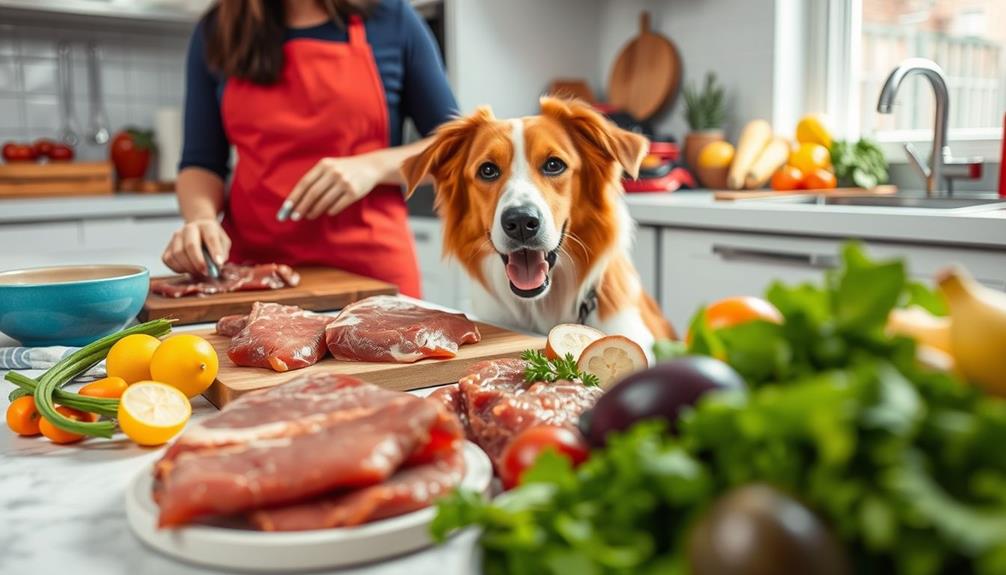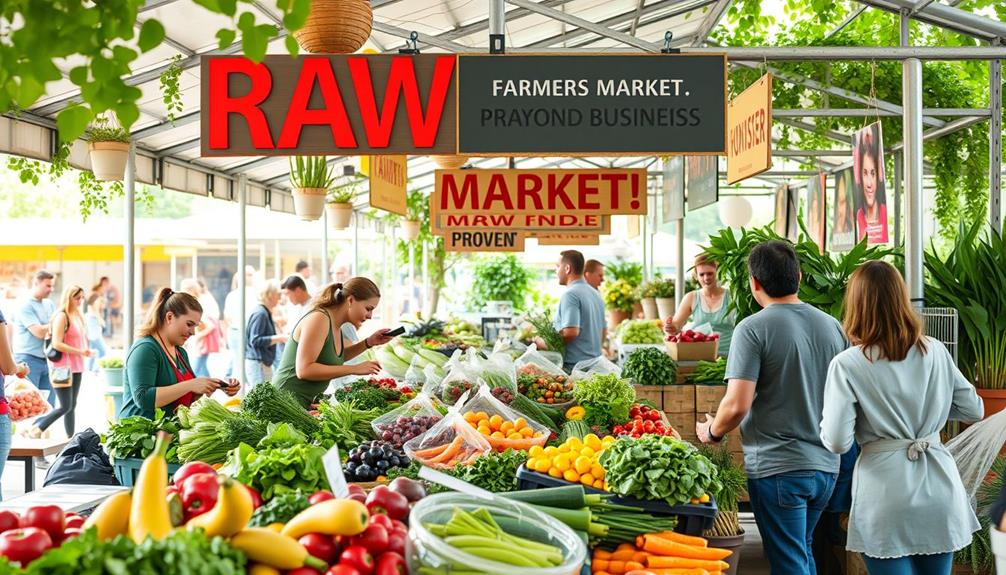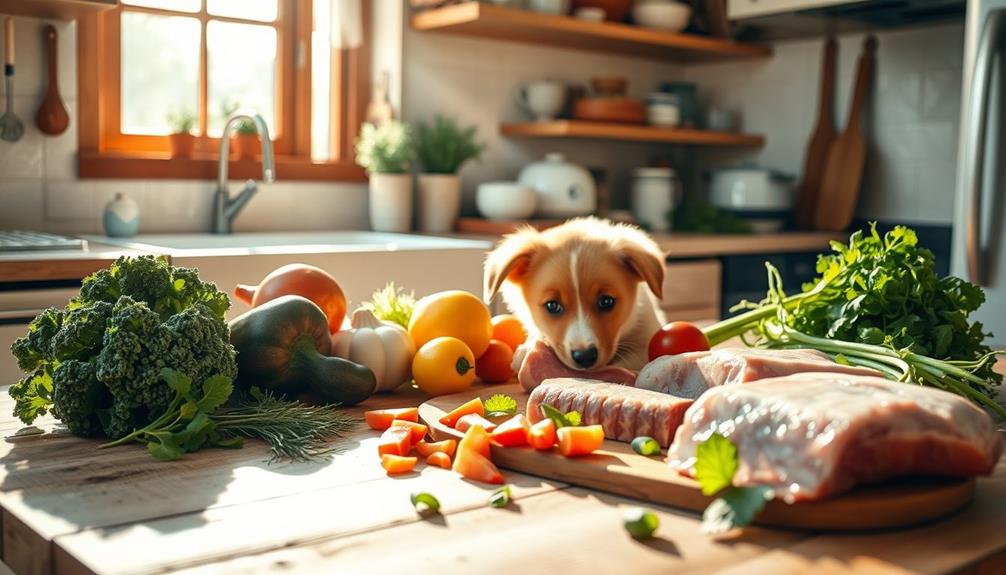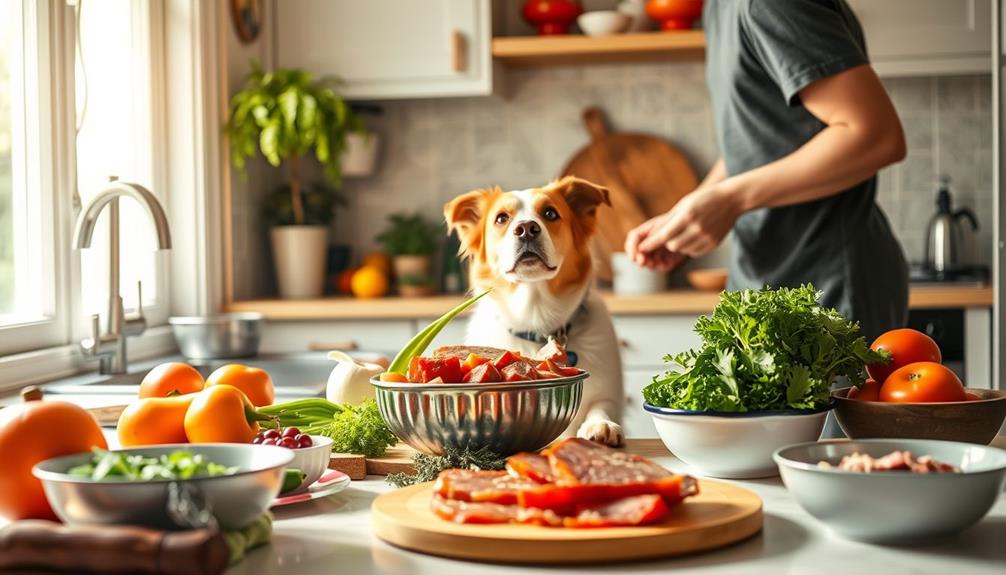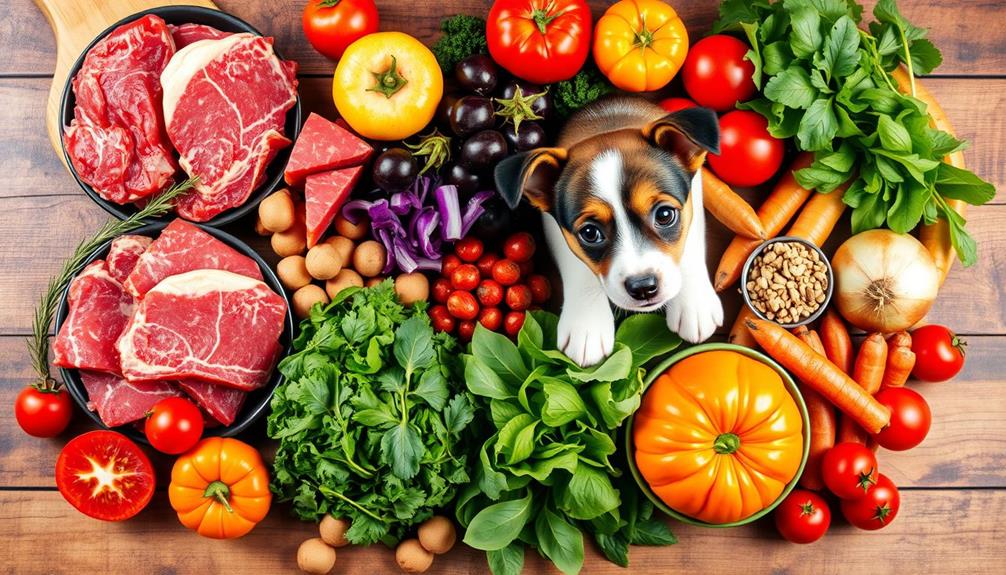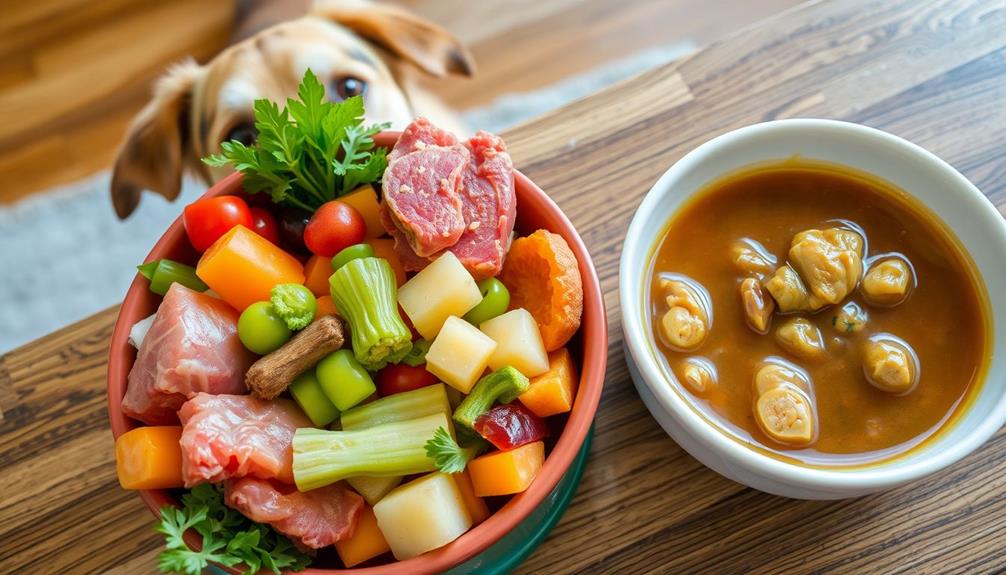To switch your dog to raw food, take it slow. Start with 75% kibble and 25% raw for three days. Then, slowly increase the raw food to 50% from days four to six, and finally aim for 75% by days seven to nine. Monitor your dog's reaction—firm stools generally mean they're adjusting well, while loose stools might indicate you should slow down. Confirm they stay hydrated and watch for signs of detox, like vomiting or bad breath. This careful approach will help your dog thrive on their new diet, and there's much more to explore about the benefits ahead.
Key Takeaways
- Gradually transition over 7 to 10 days, starting with 75% kibble and 25% raw food for the first 3 days.
- Monitor your dog's stool consistency; firm stools indicate successful adaptation, while loose stools may require a slower transition.
- Ensure constant access to fresh water to keep your dog hydrated during the dietary shift.
- Observe your dog's energy levels and behavior; improvements may indicate successful adjustment to the raw diet.
- Consult a veterinarian if severe symptoms like vomiting or persistent loose stools occur during the transition.
Understanding the Transition Process
Shifting your dog to a raw food diet requires careful planning to guarantee a smooth adjustment. Moving to raw dog food should be a gradual change over 7 to 10 days.
Start by mixing 75% kibble with 25% raw food for the first three days. This helps minimize discomfort in your dog's digestive system. It's also essential to take into account your dog's specific needs and monitor for any adverse reactions, as certain cold medications may interact with their health during this time.
Increase the amount of raw food to 50% on days 4 to 6, and then to 75% for days 7 to 9. By day 10, your dog should be fully on a raw food diet.
Keep in mind that individual responses vary; while puppies might adapt in just 1 to 2 days, older dogs or those with sensitivities may take 1 to 6 weeks. Monitoring your dog's reaction is vital during this period.
Watch for changes in stool consistency; loose stools or vomiting could mean you need to slow down the change. If necessary, skipping a meal can help clear their digestive tract and boost their appetite for the new raw food.
Gradual Vs. Rapid Switching
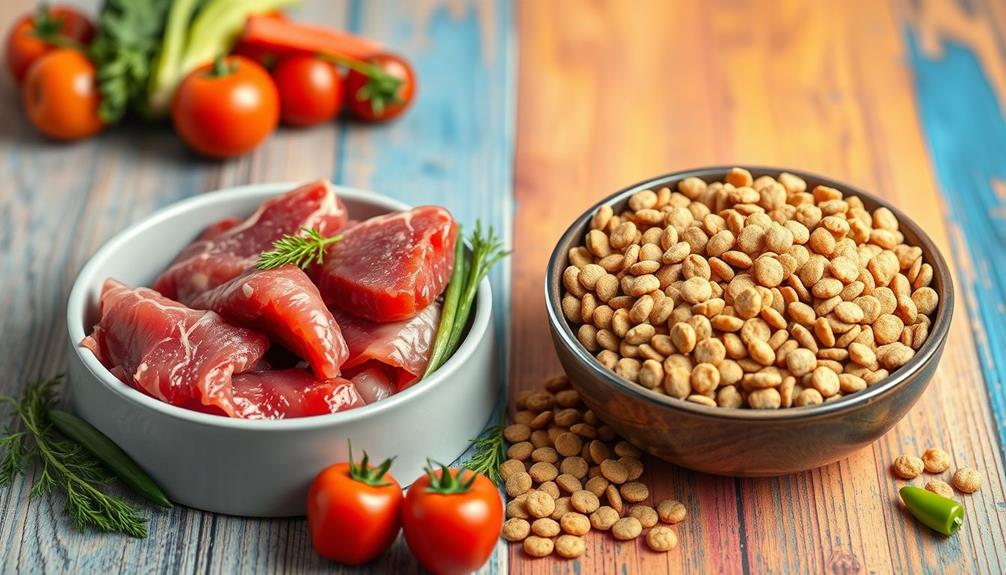
When it comes to switching your dog to a raw food diet, you have two main approaches: rapid and gradual switching. The rapid switch involves moving your dog from kibble to raw food overnight. While this might work for healthy puppies and young dogs, it often leads to digestive issues, like diarrhea or gastrointestinal upset. On the other hand, the gradual switch involves slowly introducing raw food into your dog’s diet over a period of several weeks. This allows their digestive system to adjust to the new food and reduces the likelihood of any negative reactions. It’s also important to consult with a veterinarian before making any major changes to your dog’s diet, especially when it comes to transitioning to a raw food diet for dogs. They can provide guidance and ensure that your dog’s nutritional needs are being met.
It's generally not recommended for older dogs or those with a sensitive stomach. Additionally, just like with other pets, gradual changes in diet can help ease the shift and reduce the risk of health complications, as highlighted in Ultimate Hamster Care Guide.
On the other hand, the gradual switch is a slower process, spanning 7 to 10 days. You start with 75% kibble and 25% raw food, gradually increasing the raw percentage. This method minimizes digestive distress and allows your dog's digestive system to adapt more comfortably.
For older dogs or those with sensitivities, this transition period may take 1 to 6 weeks.
During this gradual transition, monitoring stool consistency is essential. Firm stools indicate successful adaptation, while loose stools may suggest you need more bone in the diet or that you should slow down the introduction of raw food.
Monitoring Your Dog's Reaction
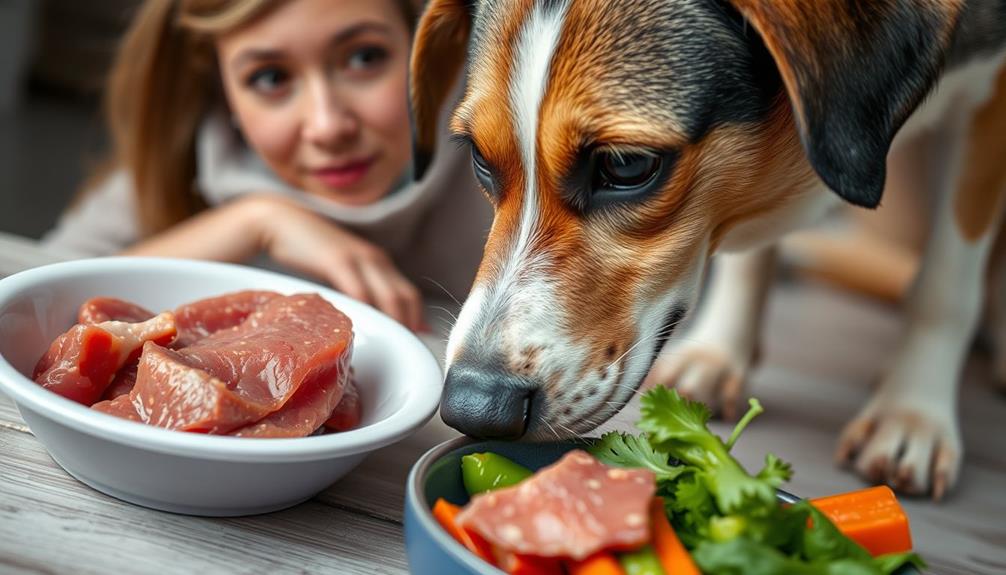
As you shift your dog to a raw food diet, it's crucial to closely monitor their reactions throughout the process. First, pay attention to their stool consistency. Typically, raw dog food leads to firmer and smaller stools. If you notice loose stools, it might indicate a need for more bone content or other adjustments in the diet.
Additionally, understanding the importance of hydration in dietary changes can help guarantee your dog changes smoothly.
Next, keep an eye out for signs of detoxification. During the initial adjustment, some dogs may experience vomiting, bad breath, or allergy-like symptoms. These usually resolve within a few days, but it's important to be observant.
Hydration is another critical aspect. Raw-fed dogs often drink less water due to the moisture in their food, but make certain they always have access to fresh water.
Additionally, track your dog's energy levels and overall behavior. Many dogs show increased energy and improved mood after switching to raw food, so any noticeable changes can guide your adjustments.
Lastly, if severe symptoms arise during the adjustment, consult with a veterinarian. Your dog's well-being is paramount, and careful monitoring will help you navigate this dietary change effectively.
Enhancing Raw Meals

Monitoring your dog's reaction to their new raw diet sets the stage for enhancing their meals. You want to make this shift as exciting as possible, so consider incorporating a few enticing additions.
For instance, introducing healthy dog snacks with natural ingredients can promote overall wellness and make the raw food more appealing. These enhancements can guarantee a balanced diet for your furry friend.
Here are some ideas to enhance their meals:
- Add cheese or your dog's favorite treats to encourage acceptance.
- Incorporate flavorful additions like canned sardines or low-sodium bone broth.
- Lightly sear the meat to release enticing aromas, gradually reducing as they adjust.
- Experiment with various fruits and vegetables to keep things interesting.
- Monitor their reaction closely and adjust additions based on their preferences.
Managing Detox Symptoms
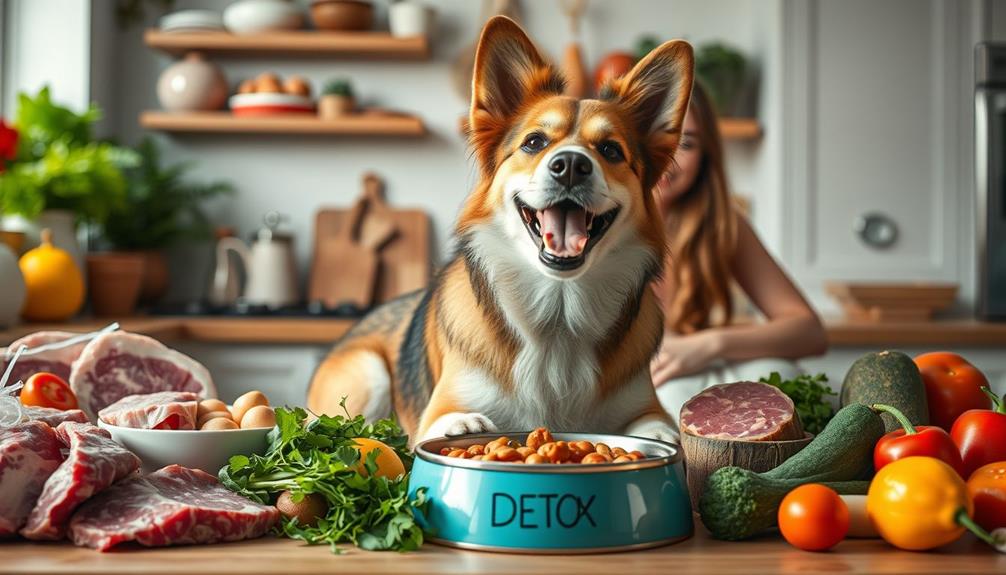
Changing your dog to a raw food diet can sometimes lead to detox symptoms, which are a normal part of the adjustment process. You might notice vomiting, loose stools, or bad breath as your dog's digestive system adapts.
While these symptoms can be concerning, they often indicate your dog's body is detoxifying. It's important to remember that just as with juice diets in humans, your dog's shift may lead to gastrointestinal discomfort initially, but this is usually temporary and manageable.
Additionally, incorporating foods rich in antioxidants, like those found in Cranberry Juice Consumption, can support overall health during this period.
If your dog experiences loose stools, try adding plain canned pumpkin to their meals. This can help firm up the stool consistency. Mucus-covered stools may also occur and generally aren't a cause for concern during this shift.
Hydration is essential, so make sure your dog has access to fresh water at all times. Since raw food contains more moisture, your dog may drink less, but it's important to keep their hydration levels up.
Monitoring your dog for any detox symptoms is critical; keep an eye on their overall well-being and adjust their diet as necessary.
If symptoms persist or become severe, don't hesitate to seek a consultation with your veterinarian. They can provide guidance tailored to your dog's specific needs and promote a smoother adjustment to their new raw food diet.
Benefits of a Raw Diet
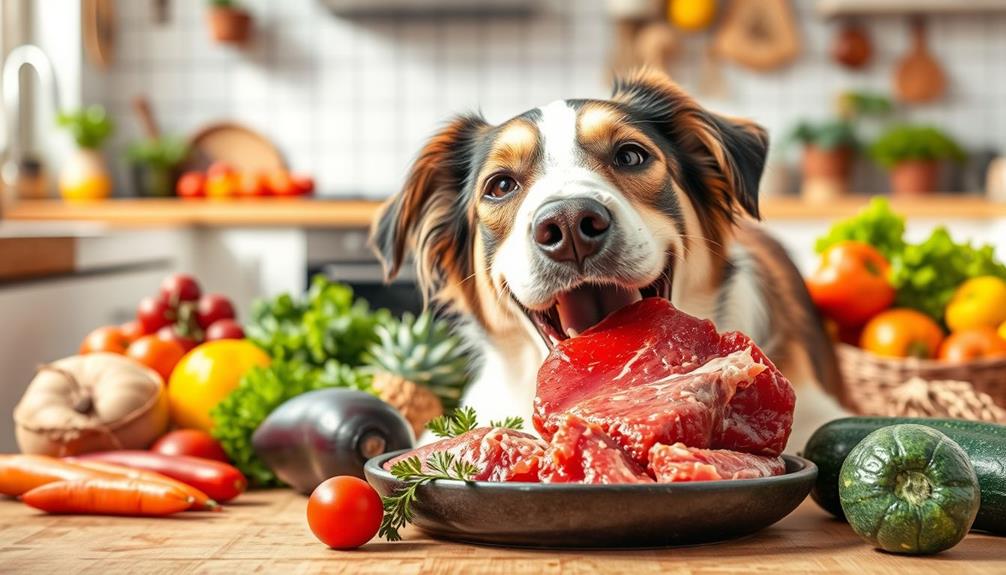
Switching your dog to a raw diet can greatly enhance nutritional absorption, ensuring your furry friend gets the most out of every meal.
Incorporating fresh, whole foods can also support their digestive health by providing natural enzymes.
You might also notice an improvement in your dog's coat health, with shinier fur and reduced skin irritations.
These benefits not only contribute to your dog's overall well-being but also make a noticeable difference in their daily energy and liveliness, similar to how yoga can alleviate back pain through holistic practices.
Enhanced Nutritional Absorption
One of the standout benefits of a raw diet for dogs is its enhanced nutritional absorption. Unlike processed kibble, which often contains fillers that inhibit nutrient uptake, a raw diet provides higher bioavailability of proteins and fats. This means your dog can better absorb essential vitamins and nutrients, considerably improving their overall health.
Additionally, incorporating essential oils for respiratory health can further support your dog's well-being by promoting easier breathing and reducing stress, which complements the benefits of a raw diet.
Switching to a raw diet can lead to:
- Improved immune system function
- Better digestion and fewer gastrointestinal issues
- Smaller, firmer stools
- Increased energy levels and liveliness
- Enhanced nutrient variety from fresh foods
With a raw diet, your dog can metabolize nutrients more efficiently, leading to better digestion. You'll notice a difference in their energy levels as they thrive on whole foods packed with essential vitamins and minerals.
These changes contribute to overall liveliness, allowing your furry friend to feel more active and engaged. Not only will you see a happier dog, but you'll also support their long-term health, ensuring they're ready for all of life's adventures.
Embracing a raw diet can be a game-changer for your dog's well-being!
Improved Coat Health
A raw diet can markedly enhance your dog's coat health, providing a noticeable boost in shine and texture. Dogs on raw diets often enjoy a shinier coat due to the rich essential fatty acids and high-quality proteins that nourish their skin.
Additionally, herbal teas like chamomile and ginger for relaxation can complement the calming effect of a raw diet. You'll likely see reduced shedding and less dander, which can make for a cleaner home environment.
The absence of fillers and grains in a raw diet improves skin health, helping to alleviate allergies and irritations that can lead to skin issues.
Additionally, the moisture content in raw foods supports hydration, essential for maintaining skin elasticity and overall coat condition.
Including nutrient-dense organ meats in your dog's meals provides important vitamins, like A and E, which are necessary for ideal skin and coat health.
Many dog owners report a noticeable improvement in coat texture and appearance within just a few weeks of switching to a raw food diet.
Your furry friend's energy will shine through, showcasing the positive impact a raw diet has on their overall well-being.
Selecting Quality Raw Food

Selecting quality raw food for your dog is essential to guaranteeing their health and well-being. When choosing the right food, prioritize brands that use high-quality ingredients sourced from reputable suppliers. This assures both safety and nutritional integrity.
Furthermore, incorporating essential beach toys into your dog's routine can enhance their overall happiness and well-being. Here are some tips to help you make the best choice:
- Look for complete balanced meals that provide a variety of proteins like beef, chicken, and fish.
- Verify the food includes necessary organ meats and supplements tailored to your dog's breed health requirements.
- Research the company's reputation; established brands often share detailed information about their sourcing and production methods.
- Compare costs of different raw food brands and consider subscription services for convenience and savings.
- Explore online resources, such as blogs and forums, for additional insights and recommendations.
Tailoring Diets for Specific Breeds
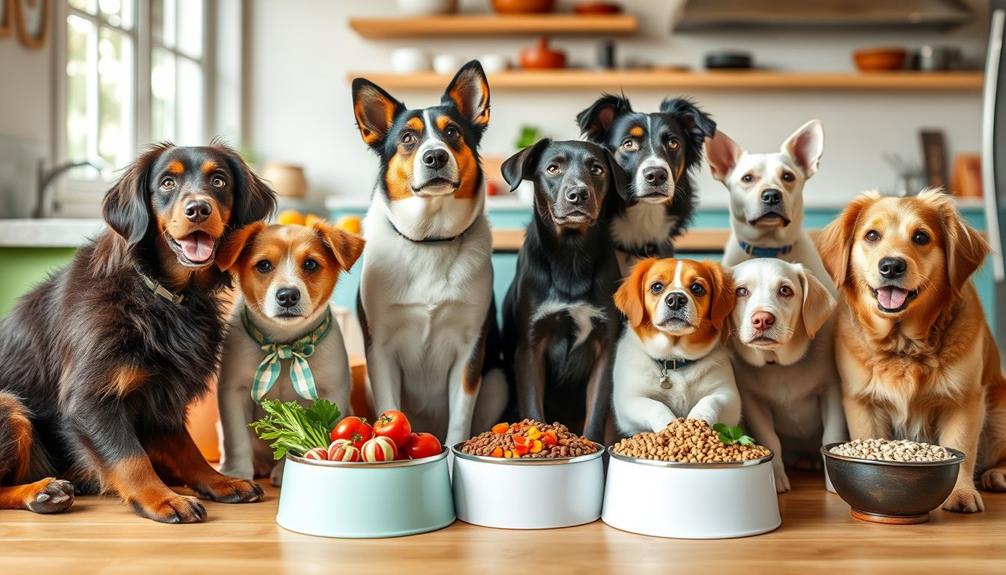
When switching your dog to a raw food diet, it's essential to take into account their breed-specific nutritional needs.
Different breeds can face unique health issues, like hip dysplasia in larger dogs or skin sensitivities in certain terriers, which means their diets should reflect those challenges.
Proper aftercare when introducing new foods can help prevent digestive issues.
Tailoring their meals with the right protein sources and ingredients can make a significant difference in their overall health and well-being.
Breed-Specific Nutritional Needs
Understanding your dog's breed is essential for crafting a raw food diet that meets their unique nutritional needs. Each breed has specific nutritional requirements that can greatly impact their health and well-being.
Consider these breed-specific needs when tailoring raw diets:
- Large breeds like Great Danes need lower protein levels to prevent rapid growth.
- Smaller breeds like Chihuahuas thrive on energy-dense foods to satisfy their high metabolism.
- Working breeds such as Border Collies require a diet rich in protein and fat to support their stamina.
- Bulldogs may benefit from lower fat diets to manage weight and reduce joint issues.
- Dachshunds need diets that support spinal health due to their elongated bodies.
Consulting a veterinarian experienced in canine nutrition can help guarantee your raw diet is balanced for your dog's breed, age, and health status.
By focusing on breed-specific nutritional needs, you can help prevent potential health issues and promote ideal weight management. Tailored raw diets not only enhance your dog's quality of life but also support their long-term health.
Common Health Issues
Many dog breeds face specific health challenges that can be addressed through tailored raw diets. For instance, large breeds like German Shepherds often struggle with hip dysplasia, which can improve with a raw diet rich in omega-3 fatty acids and joint-supporting nutrients.
Bulldogs and other brachycephalic breeds benefit from raw feeding that emphasizes lean proteins and digestive enzymes, enhancing their respiratory health and reducing skin issues related to food sensitivities.
Additionally, retrievers and terriers frequently experience allergy symptoms that can be alleviated by eliminating common kibble allergens like grains and artificial additives through a balanced raw diet.
Breeds such as Dachshunds, prone to intervertebral disc disease, require a diet with balanced calcium and phosphorus to support bone health and spinal integrity.
For working breeds like Border Collies, tailoring their raw diet to include organ meats and specific vitamins can meet their unique metabolic needs, boosting energy levels and overall performance.
Resources for Raw Feeding Support

As you commence on the journey of switching your dog to a raw food diet, tapping into available resources can make a significant difference in your experience. Connecting with others and utilizing helpful materials will ease your shift to raw dog food.
Here are some valuable resources to evaluate:
- Online raw feeding communities: Share experiences and gain insights from fellow pet owners who've successfully shifted their dogs.
- Educational resources: Blogs and FAQs provide essential information about portion sizes and understanding your dog's nutritional needs.
- Subscription services: Simplify meal planning with regular deliveries of high-quality raw ingredients tailored to your dog's dietary requirements.
- Personalized advice from veterinarians: Engage with those who specialize in raw feeding for tailored guidance and health monitoring during the shift.
- Books: Explore titles like "Natural Nutrition for Dogs and Cats" for in-depth knowledge on creating balanced raw diets at home.
Frequently Asked Questions
How Do I Transition My Dog to Raw Food?
To shift your dog to raw food, start by mixing kibble with raw in a 75/25 ratio. Gradually increase the raw portion, monitor their reactions, and adjust as necessary while ensuring they stay hydrated.
How Should I Introduce Raw Food to My Dog?
You might worry your dog won't like raw food, but start by mixing it with familiar kibble. Gradually increase the raw portion, keeping an eye on their reactions and comfort throughout the changeover.
Do Dogs Detox When Switching to Raw?
Yes, dogs can detox when switching to raw food. You might notice symptoms like vomiting or loose stools, but they usually resolve quickly. Keep an eye on hydration and stool consistency during this adjustment period.
How Do I Prepare My Dog for a Raw Diet?
Preparing your dog for a raw diet's like easing them into a warm bath—start slow. Gradually mix raw with kibble, watch for reactions, and keep hydration high to guarantee a smooth shift.
Conclusion
Switching your dog to a raw food diet can be a rewarding journey, filled with newfound energy and health. As you embrace this change, remember to take it slow and observe your pup's reaction. With the right resources and quality ingredients, you'll create meals tailored just for them. Coincidentally, you'll find that both you and your dog will enjoy this process. So, immerse yourself, trust your instincts, and watch your furry friend thrive on their raw food adventure!

